For: Everest – leading-edge drivetrain tech, strong styling, good bones. Fortuner – rugged off-road, excellent driving position, grunty engine.
Against: Everest – expensive and potentially over-egged for the customer base, no steering column reach adjust, odd third row access; Fortuner – third row seats not designed for easy removal, restricted sat nav and Bluetooth functionality on the move, yesteryear trim colours and main dials.
Scores: Everest 3.8/5; Fortuner 3.7/5
26 February 2016
By Richard Bosselman
THIS test is straight away going to cause some working for the Blue Oval to see red, for one simple reason.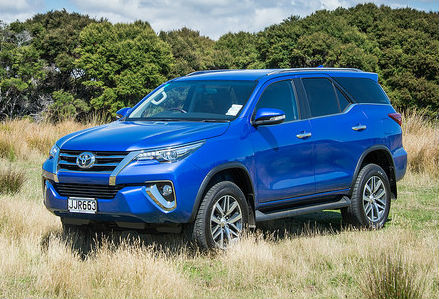
According to Ford, the Fortuner is entirely the wrong Toyota to compare their Everest against: Their take is that the Land Prado that should be in the spotlight, not just because of the price equivalency but also the off-road ability,
I take their point. And I ignore it. Those in the market for a ute-based wagon are surely going to compare like with like. And despite what Ford says about Everest being above all that, fact is anyone casting an eye over Everest is going to draw the same inescapable conclusion they will come to when looking at Fortuner. Namely, that they both have one-tonne traydeck heritage: For Ford, the parental name on the birth certificate is Ranger. For Toyota, dad’s a Hilux. There’s no denying nor disguising it.
This dual evaluation is of the top-line offers of each grime family - the $78,990 Fortuner Limited and the $87,990 Everest Titanium.
Style, specification
GREAT-looking parents never have ugly offspring, right? Well, it seems to ring true with these vehicles. They’re both classy lookers with good proportions and strong facial features.
Yes, you can quibble about the Ford being a touch over-chromed, and the Fortuner’s weak lower jawline and the way the window line rises aft of the rear door always seems to rankle someone, but overall they present really well, potentially the Ford gaining a few more votes.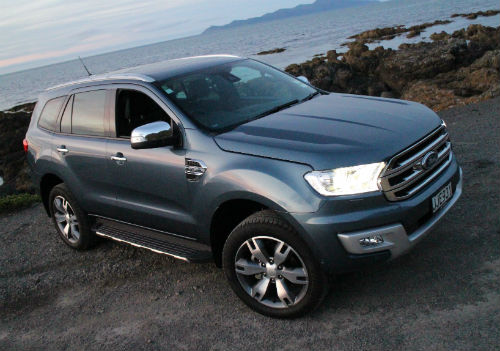
As the into says, there’s no disguising what they are. Athough Ford’s determination to fit this version of Everest with 20-inch rims (two inches larger than Fortuner’s) and side steps slightly disguises its true proportion, its ute derivation is as evident as with the Toyota. It’s in the ground clearance, the body height and bulk, the relative narrowness and the stance: All are giveaways to these vehicles having ladder-frame underpinnings and thus not spawned from cars or even monocoques. Compare with the similarly Toyota Highlander, Hyundai Santa Fe/Kia Sorrento and Ford Territory and you’ll what I mean.
They’re both sizeable vehicles, but not imposingly so. Toyota’s offers measures just under 4800mm long, 1900mm wide, 1800mm tall – making it taller, but with a shorter wheelbase and not quite as long or as wide as the Highlander it will sell alongside. You might not twig that Everest is 5mm wider, but won’t have to pace our their lengths to tell Everest is 97mm longer and has an extra 100mm between its front and rear wheels.
That extra metal is why the Ford instantly feels like a bigger machine when you slip behind the wheel. Likewise, the first impression from this model also reaffirms the brand’s proposition that, although it is related to Ranger, and shares the same platform, drivetrain and nose, it is designed and constructed to a higher standard.
To be fair, Toyota has also gone to great lengths to differentiate the Fortuner from its donor vehicle: It’s sharing forward of the (centre) B-pillar with the Hilux, yet the interior and rear of the car is unique.
Given that both strive to affect a high-end ambience, it might surprise to be told that the Ford, given it has a dash mimicking that of the Ranger (whereas Fortuner has entirely bespoke instrumentation), is slightly more effective at carrying this off, at least in Titanium spec. Yes, the hard plastics on the doors and some awkward plastic panel joins are disappointing, but aside from this the materials and colours chosen for the flagship simply lift the cabin to a level beyond where Toyota has reached, though arguably it doesn’t feel totally ‘premium’ either. At least, not when compared to those car-based options.
Fortuner is affected unfortunately by the choice of interior trim hue. Yes, the Ford has brown in it too – with faux leather lining the top of the dash – but Toyota’s use of this colour for the leather/cloth seat covers and a lot of the plastic trim has a jarring effect and, frankly, seems to unnecessarily date the vehicle.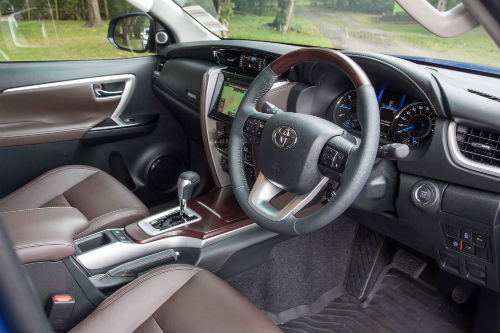
The Toyota’s dash layout is functional and everything comes to hand easily, and while it will not win any awards for innovative design, everything works well and it comes together for an overall classy look and feel, but Everest is more of a sophisticate thanks to its Sync 2 hardware.
The latter mainly presents through the central touch screen – at eight inches across diagonal, one inch bigger than Toyota’s – but also in the main instrument panel, where the driver faces digital displays either side of the analogue speedo. The left one is for infotainment functions while the right presents vehicle-related data, including a digital speedo. Because it’s so busy, some might prefer Fortuner’s more basic instrument cluster, but in age where information is everything … well, the Everest just imparts so much more. In saying that, the problem with both having touchscreens is the same, in that when off-roading, and bumping around, they’re not easy to use.
Provision-wise, Fortuner equals the Everest for leather, a reversing camera, sat-nav, auto headlights, tinted windows, a strong stereo, powered tailgate and voice control functionality. But it only gets a single zone climate control system and has no answer for Ford’s active safety features - radar cruise control, forward crash alert, rear cross traffic alert - its auto high beam, tyre pressure monitoring and hands-free parking. Fortuner does have a smart key entry and start whereas Everest, though having remote locking, asks that you put the key in a lock and turn it to fire up the engine.
Neither allows wholesale sat nav operation on the move; entry of addresses while in motion is not possible, though this can be overcome in the Ford by the voice recognition system. At least Everest allows on the move phone calls to numbers beyond already listed as previous calls on your phone directory.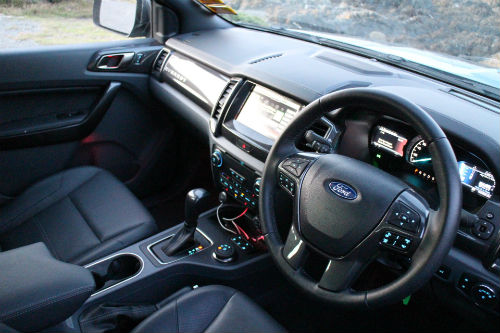
The chassis style, rear suspension intrusion and roof line means the accommodation story is one of diminishing return. You sit quite high so, while those up front do fine, the middle row is more okay than expansive in vertical height – though tall types, because they’re perching above the intrusive rear axle, will notice how close their heads get to the roof linings – and the back rows are for kids-only.Width-wise, they are also a little restrictive, but Everest is slightly superior for fitting three adults abreast in the mid-row. Both do two with absolute comfort.
The Everest’s third row is more cramped than Fortuner’s though the seats appear to be more comfortable than the Toyota’s flip-down items. In either, access is awkward. You need to load rear-most passengers first, and let them out last. Toyota’s back seats are not designed to be user-removable; there’s no clip on/off as you find with other fold-up seats.
Maker-provided boot capacity figures are from floor to roof. Toyota quotes 200 litres’ cargo volume, increasing to 716L with the third row folded away, and 1080L with the second row folded too. Ford quotes 450L behind the third row and 1050L behind the second row.
Power, performance
Same drivetrains as in the donor utes, very similar outputs – identical for the Hilux-to-Fortuner conversion (meaning 130kW of power and 450Nm of torque when mated to a six-speed automatic gearbox, or 420Nm with the six-speed manual) and slightly detuned for Everest with the 143kW power delivery being down 4kW on the ute’s, but maintaining 470Nm.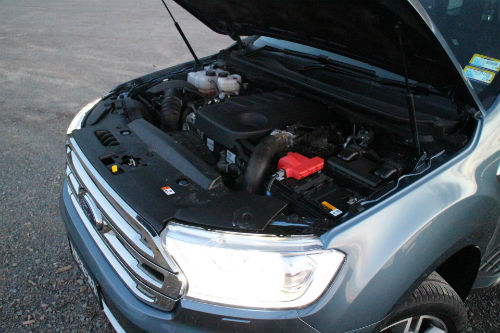
However, Everest doesn’t move as quickly as the donor ute, for two reasons. One, it’s always in four-wheel-drive and, two, it’s a heavy thing at 2500kg. That makes the Ford 400kg fatter than the Fortuner, so that kind of evens up the power-to-weight side of things. In saying that, they’re not Olympian. You’ll find more to like about the cited economy than (Everest 8.5 litres per 100km, Fortuner 8.6) than in the 12 seconds-plus non-sprint times.
When opening the Everest’s fuel latch you’ll see a blue cap; it’s the filler port for AdBlue, a urea fuel additive required to achieve clean emissions. Without it, the engine runs in a lower power output mode.
Both vehicles use a six-speed automatic gearbox and in both the stick can be left in Drive or operated manually, pulling and pushing the lever, though the Fortuner makes this redundant by offering steering wheel mounted paddle shifters. Both these transmissions are prone to hunt, even at highway speeds, dropping to fifth gear at the slightest hint of an incline.
Two other points regarding Everest. It has a sharper throttle action than Ranger and, until you attune accordingly, there’s potential to lurch from a standing start. Also, it’s noisy – even though it’s not supposed to be, because it features noise cancellation technology not used in the ute that should make a difference. But if there was one, I couldn’t hear it.
Driving
You’ll get the same message from both brands: The clear point of positive difference – not just in ride quality but also dynamic edge – over their donor models comes from the rear suspension design. Whereas the utes have simple but robust leaf rear springs, the wagons adopt a more sophisticated and more compliant independent rear end.
So now they’re cars, right? Er, no. Not even close. In fact, for the greater part, these vehicles have the feel of well-laden utilities – you get the impression of a more settled ride, yes, but also that they’re hauling a degree of substance, and that has commensurate effect on how they feel behind the wheel.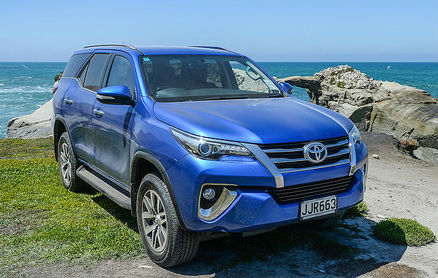
They certainly aren’t as ponderous or and roly-poly as, say, last century’s FourRunner or Pathfinder yet neither do they ever impart the frisky litheness that you get from some like-sized SUVs that don’t have ladder frames. Did you really think it would be any different?
Both have five-link rear suspensions and Everest’s more comfortable over bumps, ruts and undulations. The Fortuner is firmer and feels some impacts that don’t seem to trouble the Ford. But there’s no great difference; continuous corrugations will cause both to buck their bottoms.
One aspect that dictates your driving style is the steering feel. The Everest has electric assist, the Toyota works with hydraulics, but both are a bit vague about centre. Under load the Toyota’s feels better and more ‘natural’; there is more communication and weight, which helps with placing the car on the road.
The Ford feels more confident because it has a constant four-wheel-drive, whereas with Fortuner – due to its part-time set-up – should only be in four-wheel-drive on loose-traction surfaces like dirt, sand, snow and mud. On seal stick to two-wheel-drive.
You can go off-road and tow big with confidence in either vehicle and damn well better try: That’s why they’ve been developed.
In the Fortuner, it’s easy but old-school – with a dual range transmission, albeit with a small switch control rather than a big lever. You can switch between a two- and four-wheel drive high-range mode and also enter a four-wheel drive low-range mode (though you need to stop to engage and disengage). Additionally, a manually lockable rear differential and hill-descent control helps expand the four-wheel drive ability.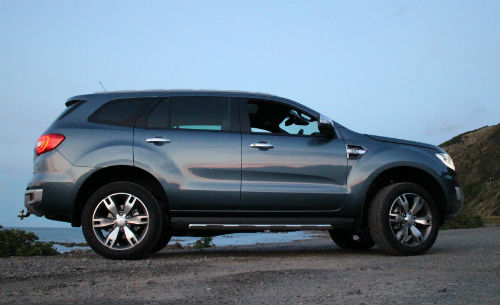
Everest is right at the peak of advancement. It also features a low-range gearbox and speed-variable hill descent control, but then goes higher tech with an electronically controlled clutch as its centre differential, a manually lockable rear differential and a Terrain Management System, which can vary traction control intervention, torque diversion between axles and throttle sensitivity. TMS also works independently of the low-range and rear differential lock to vary stability control intervention, traction control severity and throttle response and has four modes: Normal, Grass/Gravel/Snow, Sand and Rock.
The Normal mode is used for regular driving, where the drive system can shuffle torque between the front and rear axles as required, but can also be employed in low-range and/or with the rear differential locked. In the other modes the throttle becomes less sensitive, gears shift up earlier and downshifts occur later. Rock mode is the most hardcore setting.
Fortuner has a 30-degree approach angle and 25-degree departure angle, Ford quotes 29.5 and 25. Everest’s 800mm wading depth allows it to go 100mm deeper than Toyota recommends. Ground clearance-wise, TNZ insists on quoting a running clearance of 279mm, but in Australia it has been revised to 225mm, the same as Everest has. It’s not a eebate I want to enter but, since both markets take common vehicles … well, draw your own conclusions and err on the side of caution.
In terms of off-road ruggedness ... sorry, ultimately you’d need to encounter conditions far more extreme than the test vehicles were subjected to in order to discover how much extra advantage Everest, with its fancier approach, provides over Fortuner.
Towing will be the other prime motivation for purchase and both are in the big league. Ford has a slight advantage; Everest is rated to tow 3000kg with a braked trailer whereas that limit, in respect to Fortuner, applies to the manual model. The auto peaks at 2800kg. It’s 750kg either way with an unbraked trailer.
Verdict
If best tech is the be-all, then Ford wins. Everest also gets ahead for attention to detail, ergonomic consideration and styling.
Fortuner nonetheless might seem a better buy: Why buy a chainsaw if all you need is an axe? The fundamental challenge is that, unlike Everest, it has no ability to operate in all-wheel-drive all of the time; something that might might would likely be a salient difference for me were I in the market.


